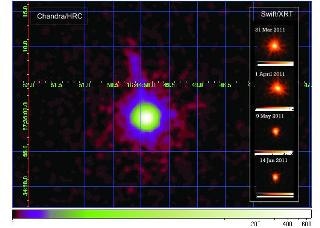Sep 20 2017
Astrophysicists from Moscow State University have found a new way to estimate the mass of supermassive black holes outside our galaxy, even if these holes are barely detectable. The results of the study were published in the Astronomy and Astrophysics journal.
 The Chandra/HRC (0.3-10 keV) image of the Swift J1644+57 field of a view (FOV) was observed on 2011 April 4 (MJD=55655) with the 15 ks exposure. Evolution of the Swift/XRT (0.3 - 10 keV) image is plotted in the incorporated vertical panels which clearly demonstrate the outburst decay phase of Swift J1644+57 (Credit: Elena Seyfina)
The Chandra/HRC (0.3-10 keV) image of the Swift J1644+57 field of a view (FOV) was observed on 2011 April 4 (MJD=55655) with the 15 ks exposure. Evolution of the Swift/XRT (0.3 - 10 keV) image is plotted in the incorporated vertical panels which clearly demonstrate the outburst decay phase of Swift J1644+57 (Credit: Elena Seyfina)
Black holes are hypothetical objects whose gravitational pull is so great that even light cannot leave them. The existence of black holes follows from the solutions of Einstein's equations. Scientists have repeatedly observed the result of the black hole interaction with the surrounding matter, for example, gas falling into the hole.
"If a black hole absorbs a substance, there is a so-called accretion. Due to friction and heating, it causes radiation which allows us to indirectly see the object and say that this is a black hole," explained Elena Seifina, the leading researcher of the SAI MSU. "If black holes do not have such a recharge, then we may not even suspect of their existence."
To understand the nature of such "sleeping" black holes astronomers led by Elena Seifina turned to several outbreaks from extragalactic sources. One of them, Swift J1644 + 57, was observed in 2011 simultaneously by several cosmic observatories (RXTE, Swift and Suzaku) in the X-ray and gamma-ray ranges.
At first scientists thought that they were seeing another gamma-ray burst (GRB), similar to that observed in remote galaxies in the hardest range of the electromagnetic spectrum. However, usually the radiation of such flares disappears in a day or two, which was different in the case of Swift J1644 + 57. "The BAT tool at the Swift satellite was aimed at it and saw that two days later the splash became even brighter. The whole outburst was observed for two years and then it went out," Elena Seifina explained.
Astronomers excluded the object from the GRB list and suspected that they were observing the tidal destruction of the star by a supermassive black hole. A star flying a short distance from a black hole undergoes tidal destruction. In this case its substance does not fall on the hole at once, but forms a temporary accretion disk, which starts to glow brightly. This can be seen from the Earth.
Previously, the only way to measure the mass of a black hole at the center of such accretion disks was to estimate the maximum luminosity of a disk, assuming that equilibrium is established between the pressure of electromagnetic radiation and gravitational forces in the disk.
In her doctoral thesis Elena Seyfina previously observed similar known flares (involving black holes) both inside our galaxy and beyond and found out how the X-ray spectrum tilt changes during the increase in luminosity. Specific features of the spectrum were found which clearly indicated the presence of black holes in these objects. The scientists assumed that if the shapes (or the evolution of the shape) of the spectra of similar flares are similar, then the processes occurring in them are also similar, and the normalization of the spectra is determined only by different distances to the objects and their mass.
Noticing the similarity between the tracks (the dependence of the spectral tilt on the rate of accretion) of known objects and the tracks obtained in new extragalactic flares, the scientists suggested that they are also caused by the stars torn by black holes. This allowed us to "weigh" invisible black holes in a new way, comparing them with galactic black holes of known mass.
Thus, a new method of "weighing" sleeping extragalactic black holes allows us to use data on known galactic objects like, for example, well-known and long-studied Cygnus X-1 with a black hole in the center. "Calculations showed that Swift J1644 + 57 contained a supermassive black hole with a mass of 7×106 solar masses. This is really an object that we do not see, but which provided high luminosity due to its strong gravitational field and an accretion disk around it," explained Elena Seifina, the author of the paper.
Previously, the assessment of supermassive black hole masses also used ultraviolet, but for the new method the x-ray range is enough. Scientists hope that the versatility of the new method will be helpful in assessing the mass of various extragalactic objects, such as the cores of Seyfert galaxies and others, where traditional methods do not work in principle.